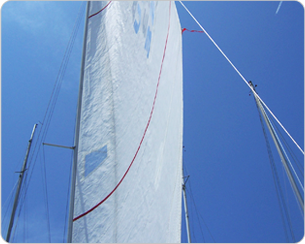The Importance of Sail Trim in Sailboat Racing
To do well in sailboat racing, you need to know more than how to sail; you need to know how to sail really well. Sailing well means not only understanding how to sail, but how to trim the sails to drive the boat at top speed under a variety of wind and wave conditions. In many cases, poor performance in sailboat racing can be traced to not understanding the finer points of sail trim. USITA Long Beach recognizes this and offers classes in basic and advanced sail trim. Classes are conducted informally, generally by a more experienced sailor offering to crew for a skipper who is interested in improving their sailing skills. The following discussion provides several concepts which must be mastered to race a Tempest really well. Needless to say, the concepts apply to a wide variety of racing sailboats, not just Tempests.

Determining the Optimum Rig Tension
Finding the optimum rig tension is a trial-and-error procedure. Whether you have an older Mark I or a newer Mark II Tempest, disconnect the mast lever from the mast. Also, if you have one, make sure the backstay is disconnected. Now, you need to tension the rig. On a Mark I, this is accomplished by tensioning the forestay or closing the shroud lever located in one or both of the shrouds. On a Mark II, you can increase shroud tension alone or increase both shroud tension and forestay tension.
With the rig tensioned, stand in the boat facing forward, just aft of the mast and grab the mast at shoulder height with one hand. Check how much effort is needed to bend the mast fore and aft. Increase rig tension and note how much easier it is to bend the mast. You will note that as you increase rig tension, it will become increasingly easier to bend the mast. Here’s where the trial-and-error procedure comes in. Continue increasing rig tension until there is no noticeable increase in the ease with which you can bend the mast. At this point, the mast is behaving like the batten on the bathroom scale at the end of our experiment. Although we are applying a greater load on the mast, causing it to become increasingly less stable, there is no significant increase in the tension in the shrouds and forestay.
To quantify your subjective analysis, measure the tension in the shrouds or forestay using either a standard Loos tension gauge or the more expensive Harken digital tension gauge. By keeping track of shroud (or forestay) tension as you increase rig tension, you will quickly see the point where increasing rig tension results in only a modest increase in shroud (or forestay) tension, but the mast becomes really bendy or unstable. The goal is to find that point where you have a relatively high rig tension without making the mast so bendable that it has very little vertical stability.
Pre-bending the Mast
Because rig tension causes the mast to become unstable or “bendy,” the right amount of pre-bend is critical. A good way to understand this is to use the following thought experiment. You are hiking along a beautiful mountain trail, and you come across a stream that you want to cross without walking through it. You find a wooden board long enough to cross the stream and support it on the banks on either side of the stream.
As you walk on the board above the stream, it bounces up and down. Now, envision hanging a heavy weight from the midpoint of the board. Naturally, the board is going to bend downward. The heavier the weight, the more it will bend. Now, when you walk across the board, the board is much more stable, and there is less bouncing. The reason for this is that by hanging a weight on the board, you are “preloading” the board. Because the board is preloaded, the oscillating, vertical load caused by your walking across the board has less impact on the board. The heavier the weight that you hang from the board, or the greater the preload, the more this is true.
Without applying pre-bend to a mast under load, it will behave much like the board placed across the stream. As a boat moves through the water, it is periodically slowed by waves. Each time the boat is slowed, the force of the sail pushing forward on the mast increases, causing the mast to bend. When the boat picks up speed, the force of the sail against the mast is reduced, and the mast straightens up. As the boat moves through the ocean, the mast is constantly in motion, either bending when the boat pushes into a wave or straightening as the boat accelerates back to full speed. So, now that we know we need to pre-load the mast, how do we do it?
On a Tempest, the mast is preloaded in one of two ways. On the older design Mark I, the situation is relatively simple. We use the mast lever to bend the mast, typically one mast-width. On the newer design Mark II, the situation is more complicated. We can tension the shrouds, which push the spreaders forward, bending the mast. Alternatively, we can bend the mast with the mast lever.
Once again, your sailmaker is well aware that you need to pre-bend the mast to stabilize after the rig has been tensioned. Clearly, to get the most out of your mainsail, you need to know how much mast bend your sailmaker factored into the luff curve of this sail. As a rule of thumb, this is one mast-width.
